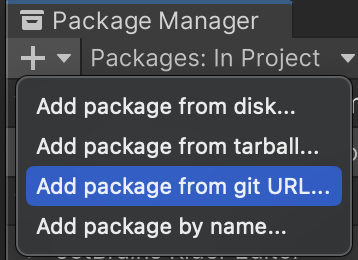https://github.com/lazysquirrellabs/min_max_range_attribute
A bounded (i.e., with a minimum and maximum) range attribute for Unity's Vector2 and Vector2Int fields.
https://github.com/lazysquirrellabs/min_max_range_attribute
game-development gamedev unity unity-editor unity-tools unity3d-plugin
Last synced: 7 months ago
JSON representation
A bounded (i.e., with a minimum and maximum) range attribute for Unity's Vector2 and Vector2Int fields.
- Host: GitHub
- URL: https://github.com/lazysquirrellabs/min_max_range_attribute
- Owner: lazysquirrellabs
- License: mit
- Created: 2023-10-25T15:11:38.000Z (about 2 years ago)
- Default Branch: main
- Last Pushed: 2025-04-20T07:33:44.000Z (7 months ago)
- Last Synced: 2025-04-26T07:39:45.949Z (7 months ago)
- Topics: game-development, gamedev, unity, unity-editor, unity-tools, unity3d-plugin
- Language: C#
- Homepage: http://minmax.matheusamazonas.net
- Size: 539 KB
- Stars: 22
- Watchers: 1
- Forks: 1
- Open Issues: 1
-
Metadata Files:
- Readme: README.md
- License: LICENSE
Awesome Lists containing this project
README
# Min/max Range Attribute

A bounded (i.e., with a minimum and maximum) range attribute for Unity's `Vector2` and `Vector2Int` fields that draws fields as min/max range sliders, easing the definition of bounded ranges on the inspector.

[](https://assetstore.unity.com/packages/tools/utilities/min-max-range-attribute-302500)
## Features
- Intuitive, compact inspector representation.
- Support for Unity's `Vector2` and `Vector2Int` types.
- Easy to use: just add the attribute to a serialized field of a supported type.
- Custom floating-point decimal places (0 to 3).
- Error prevention. Unlike using separate fields for minimum and maximum, value integrity is guaranteed (e.g., the minimum will never be greater than the maximum) by the inspector.
- Uses built-in Unity's [`EditorGUILayout.MinMaxSlider`](https://docs.unity3d.com/ScriptReference/EditorGUILayout.MinMaxSlider.html) under the hood.
## Usage
To use the attribute, simply add it to a serialized field of a supported type (`Vector2` or `Vector2Int`). Its inspector representation will be a [`MinMaxSlider`](https://docs.unity3d.com/ScriptReference/EditorGUILayout.MinMaxSlider.html), a slider than can be used to represent a range within minimum and maximum limits. The left handle controls the vector's `x` component and the right handle controls the vector's
### Vector2 usage
When using the attribute on a field of type `Vector2`, its constructor takes 3 arguments:
- `minLimit`: the minimum possible value (lower bound).
- `maxLimit`: the maximum possible value (upper bound).
- `decimals`: how many decimal places the inspector should display. Default is 1 and values must be in the [0, 3] range.
For example, the field below has `minLimit` equal to 0, `maxLimit` equal to 10 and `decimals` equal to 3:
```csharp
[MinMaxRange(0f, 10f, 3)]
[SerializeField] private Vector2 _optimalSpeed = new (3.141f, 5.789f);
```
And its inspector representation is:

If `decimals` is 2 (`MinMaxRange(0f, 10f, 2)`):

The default value of `decimals` is 1, so we might as well omit the parameter if we would like to display only 1 decimal place:
```csharp
[MinMaxRange(0f, 10f)]
[SerializeField] private Vector2 _optimalSpeed = new (3.141f, 5.789f);
```
Which will be displayed as:

Keep in mind that the `decimals` parameter only controls how the value labels will be displayed on the inspector. It doesn't control the values' precision.
### Vector2Int usage
When using the attribute on a field of type `Vector2Int`, its constructor takes 2 arguments, similar to `RangeAttribute`'s parameters:
- `minLimit`: the minimum possible value (lower bound).
- `maxLimit`: the maximum possible value (upper bound).
For example, the field below has `minLimit` equal to 0 and `maxLimit` equal to 10:
```csharp
[MinMaxRange(0, 10)]
[SerializeField] private Vector2Int _rewardRange = new(2, 4);
```
And its inspector representation is:

## Importing
The first step is to import the library into your Unity project. There are three ways to do so:
- [Via the Asset Store](#import-via-unity-asset-store).
- Via the Package Manager:
- [Using a git URL](#import-using-a-git-url).
- [Using OpenUPM](#import-with-openupm).
### Import via Unity Asset Store
Click on the image below to visit the package's page on the Unity Asset Store. One there, follow the instructions to import it into your project.
[](https://assetstore.unity.com/packages/tools/utilities/min-max-range-attribute-302500)
### Import using a git URL
This approach uses Unity's Package Manager to add the attribute to your project using the repo's git URL. To do so, navigate to `Window > Package Manager` in Unity. Then click on the `+` and select "Add package from git URL":

Next, enter the following in the "URL" input field to install the latest version of the attribute:
```
https://github.com/lazysquirrellabs/min_max_range_attribute.git?path=Assets/Lazy Squirrel Labs/MinMaxRangeAttribute
```
Finally, click on the "Add" button. The importing process should start automatically. Once it's done, the attribute can be used in your project.
### Import with OpenUPM
Min/max Range Attribute is available as a package on [OpenUPM](https://openupm.com/packages/com.lazysquirrellabs.minmaxrangeattribute/). To import it into your project via the command line, run the following command:
```
openupm add com.lazysquirrellabs.minmaxrangeattribute
```
Once the importing process is complete, the attribute can be used in your project.
## Compatibility and dependencies
The Min/max Range Attribute requires Unity 2021.3.X or above, its target API compatibility level is .NET Standard 2.1, and it does not depend on any other packages.
## Contributing
If you would like to report a bug, please create an [issue](https://github.com/lazysquirrellabs/min_max_range_attribute/issues). If you would like to contribute with bug fixing or small improvements, please open a Pull Request. If you would like to contribute with a new feature, [contact the developer](https://matheusamazonas.net/contact.html).
## Getting help
Use the [issues page](https://github.com/lazysquirrellabs/min_max_range_attribute/issues) if there's a problem with your setup, if something isn't working as expected, or if you would like to ask questions about the tool and its usage.
## License
Min/max Range Attribute is distributed under the terms of the MIT license. For more information, check the [LICENSE](https://github.com/lazysquirrellabs/min_max_range_attribute/blob/main/LICENSE) file in this repository.